QCF: Oddworld: SoulStorm
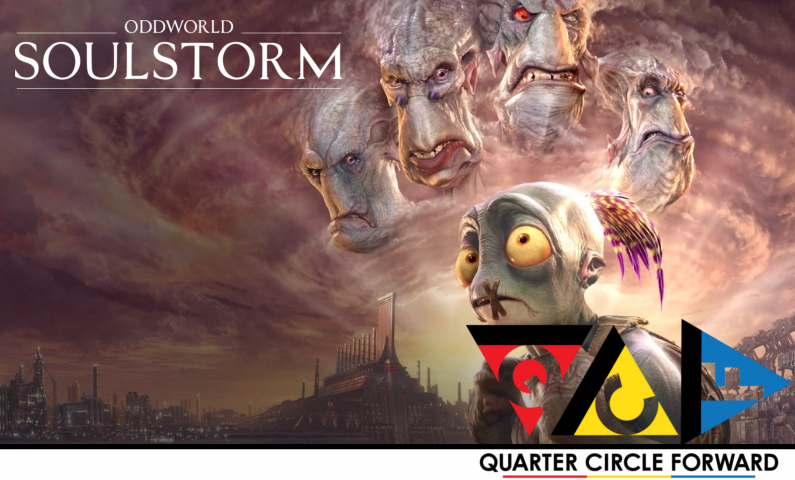
 egardless of how obscure it may be in the milieu of video gaming, Oddworld has always been a name that’s commanded a dedicated following, with titles that strive to deliver a unique gameplay experience under a presentation that’s teeming with a special kind of cinematic spectacle that plays out like a Steven Spielberg meets Jim Henson passion project.
egardless of how obscure it may be in the milieu of video gaming, Oddworld has always been a name that’s commanded a dedicated following, with titles that strive to deliver a unique gameplay experience under a presentation that’s teeming with a special kind of cinematic spectacle that plays out like a Steven Spielberg meets Jim Henson passion project.
Where Oddworld Inhabitants have remained consistent with this goal, their last remake, Oddworld: New ‘n Tasty, managed to improve everything good about the original it remakes while introducing a slew of other upgrades to the overall experience, and proved that there was plenty of potential left for Abe’s adventure in the modern era of gaming.
Stepping a few feet away from the familiar absurdity of its fart-fueled roots this time around, Oddworld: SoulStorm leans a little heavier into the real themes the series had previously broached like capitalism, civil rights, racism, gentrification, and predestination.
The end-result makes for one of the most memorable titles this generation has seen in recent memory.
Abe’s world of Oddities always had a visual panache to its dystopian landscape but SoulStorm kicks up a notch with a graphical overhaul and advanced camera perspective that drives home how weird and screwed up this place really is.
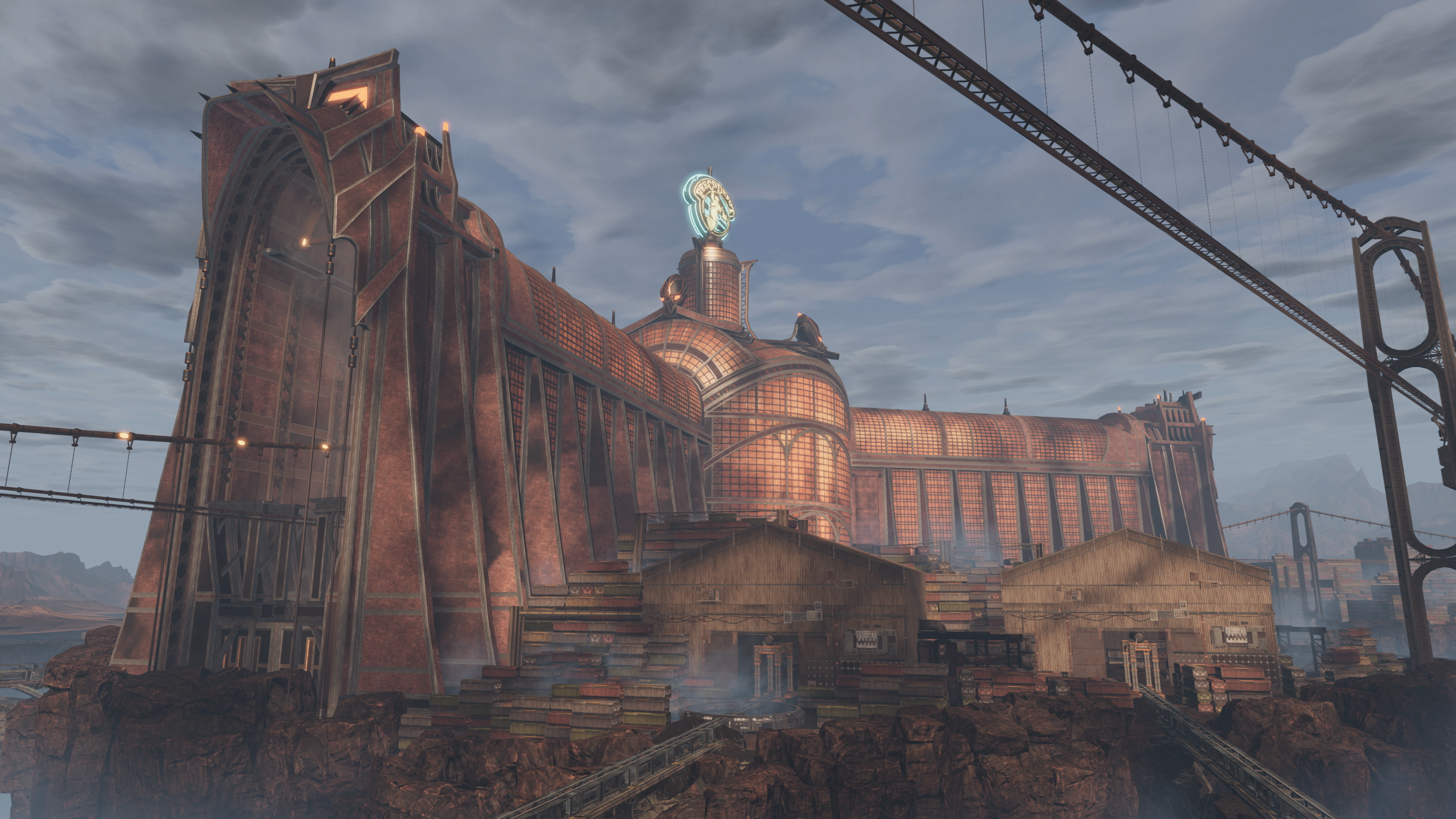
Utilizing the 2.5 space of the foreground and background like its 32-bit predecessor, SoulStorm opts for a full-sweeping 3D environment that pans and moves around a side-scrolling track, with forks in the path that can stretch into the foreground or background, muck like Namco’s Klonoa series. While the DNA of the Prince of Persia inspired single-screen platforming is still present within the gameplay, the level design opts for a more traditional full scrolling setup that’s loaded with the aforementioned affections, and the efforts are just stunning.
The depth of field has an impressive scale that has a vast span across many of the vibrant environments of the Oddworld universe, containing a sense of detail that’s utterly beautiful to look, and satisfying to explore. It may sound silly lavish the draw distance and texture mapping work of a 2.5D side-scrolling game but the fidelity behind SoulStorm’s graphics truly make the difference in visually defining all of the various obstacles and exploratory frameworks of each stage. Despite the occasional cryptic entry puzzle to solve, the sweeping path system cleverly uses the three-dimensional space with innovative juncture points between the different axes of the stage, like a pathway under a bridge that’s otherwise obscured once the camera view is fixed on the profile of the structure from a linear approach. Even though the levels get steadily denser in complexity, they still manage to deliver on the sense of discovery throughout the majority of the game’s main campaign. To clarify, the version I’m reviewing is the PS4 version, but it is being ran on a PS4 Pro with 4K HDR modes enabled, and the immaculate attention to detail to the various textures and environmental effects at work are simply stunning for “legacy” port.
The larger-than-life presentation and advanced level design aren’t the only big improvements to take center stage though—Abe now has access to a new crafting system, and it’s surprisingly more intuitive to the gameplay than initial impressions of the system’s introduction would suggest.
In addition to scouring each stage for Mudokon brethren to rescue, players will also need to raid for item that can also act as resources from assorted caches in order to craft tools that are needed to navigate the level, or at some points to complete it even during the later portion of the title. The items are simple at first, like water bottles that be used to put our fires, or the highly flammable SoulStorm Brew that spread, and even explode said fire when the situation calls for it. Eventually, however, they will fit into more nuanced uses, like a smoke bomb that can be used to hide players and their rescued friends from hostile enemies who can’t be avoided otherwise. Admittedly, most of the crafting is contextual to the main progression of SoulStorm, but there are a number of metagame uses they offer that can useful for players who’re hunting for every collectible, or even speed-running the game that make the difference to an otherwise familiar formula.
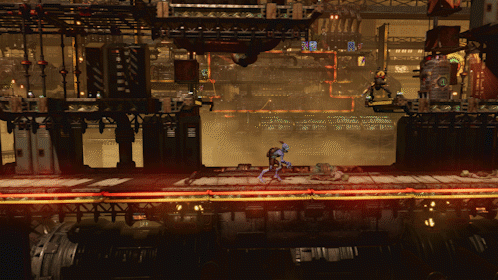 Speaking of the familiar formula, there have been some other shakeups to the Mudokon stewarding mechanic that are changed for better and for worse. For starters, some levels won’t have any new Mudokons for you to save, but a gauntlet of lethal hazards to Shepard your current herd through instead. While these instances can be a palate cleanser to the puzzle-heavy flow of the game, the trial and error dynamic of SoulStorm’s opposition carry much bigger stakes thanks to an all too active checkpoint system that permanently charts your position the moment it’s triggered.
Speaking of the familiar formula, there have been some other shakeups to the Mudokon stewarding mechanic that are changed for better and for worse. For starters, some levels won’t have any new Mudokons for you to save, but a gauntlet of lethal hazards to Shepard your current herd through instead. While these instances can be a palate cleanser to the puzzle-heavy flow of the game, the trial and error dynamic of SoulStorm’s opposition carry much bigger stakes thanks to an all too active checkpoint system that permanently charts your position the moment it’s triggered.
While a frequent checkpoint chart may seem like a good idea for a game as challenging as SoulStorm, players can only restart from the most recent checkpoint reached. This limitation
means that if there was even one mistake during a sequence where players are trying to defend their tribe, the irreversible update could spoil that perfect run of zero casualties, where the only way to make up for it is to abort the level and start it over from the very beginning. This was made even more frustrating by some shoddy UI design in the launch version of the game where the option to restart the last checkpoint after a failed attempt hovered just above the “Restart Level” option, a selection that if triggered, did not prompt for a confirmation from the player to do so—it just did it. Folks, nothing will kill a mood like pissing away an hour or so of progress within the blink of an eye. Thankfully, Oddworld Inhabitants patched this oversight out with a new prompt for the selection now. One of the big omissions from the game is the advanced Gamespeak engine from Abe’s Exoddus that introduced more expressions and responses to emote with other Mudokons beyond the simple greeting and command system from Abe’s Odyssey.
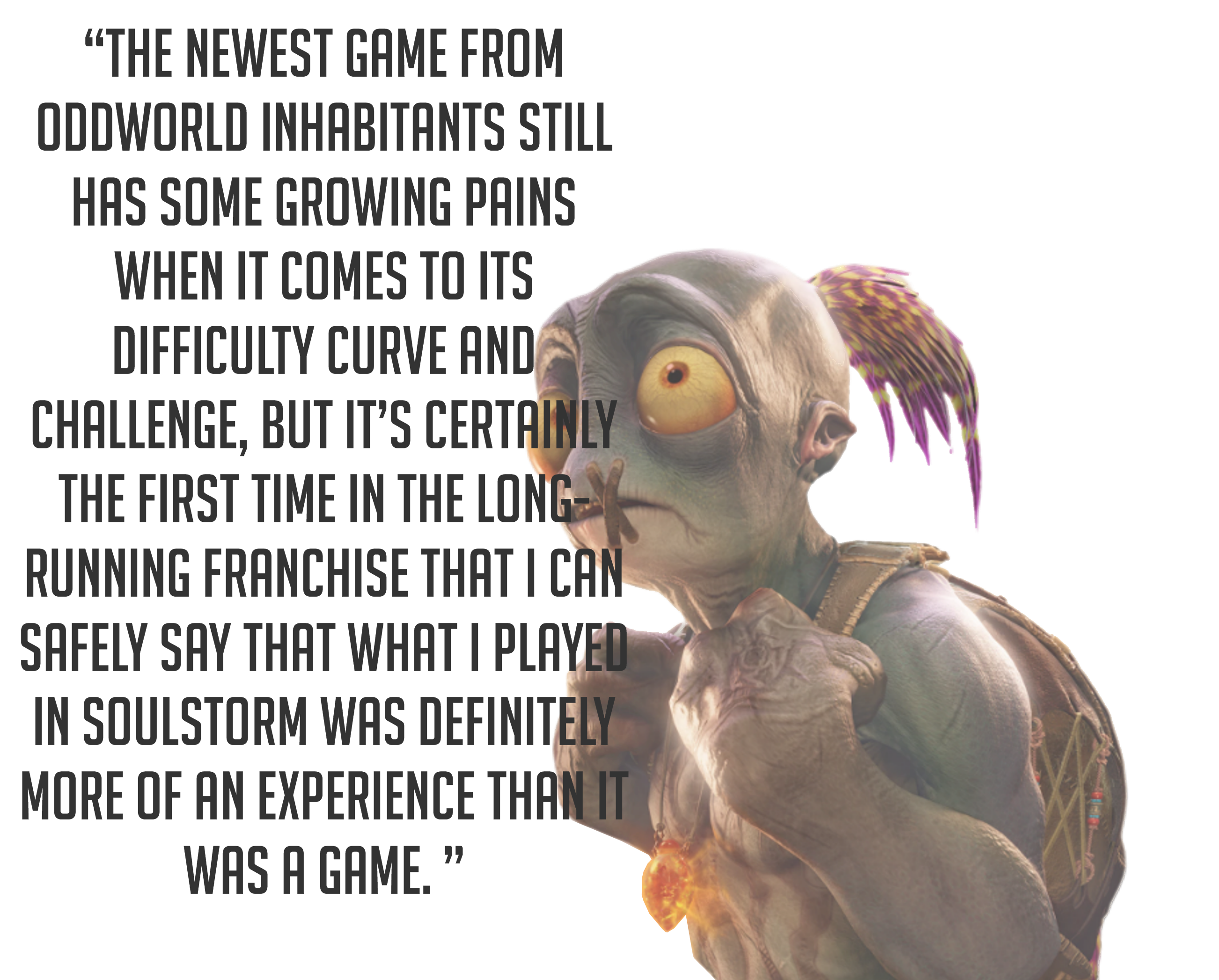 The only addition to the system is that players can alter Abe’s approach to either be slightly more aggressive, or passive, influencing the mood of his group in response—as far as I could tell though, this cause anything meaningful to happen on-screen though aside from some variance of the NPC banter from the Mudokon followers. Regardless of the tone I took with them, there was no sign dissent or mutiny, of lackadaisical disposition from my herded friends, rendering the feature into nothing more than a superficial gimmick.
The only addition to the system is that players can alter Abe’s approach to either be slightly more aggressive, or passive, influencing the mood of his group in response—as far as I could tell though, this cause anything meaningful to happen on-screen though aside from some variance of the NPC banter from the Mudokon followers. Regardless of the tone I took with them, there was no sign dissent or mutiny, of lackadaisical disposition from my herded friends, rendering the feature into nothing more than a superficial gimmick.
Speaking of Abe’s Exoddus, where Oddworld: SoulStorm is a direct sequel to Oddworld: New ‘n Tasty (a direct remake of Oddworld: Abe’s Odyssey,) SoulStorm isn’t a direct remake of the Original’s 1998 sequel. This modern sequel is more of a reimagining of it instead, taking only some loose bits of its narrative that would best fit into the more mature plot direction of Abe’s 2021 journey.
 Taking place shortly after the events of New ‘n Tasty’s conclusion, heavy is the head that wears the crown as Abe is suddenly coming to grips with the responsibilities he holds as the savior of downtrodden race, and the example he must lead in their post-slave life. Instead of treating the situation like the reluctant yet goofy hero that we have to know him as, we’re treated instead to a terrified Abe, a character who’s afraid to let go of his trauma because it’s one thing that ties him to his mother. It doesn’t take long before shit hits the fan, with Mullock the Glukkon in hot pursuit of the Mudokon workforce that escaped him, leading to panic and tragedy in the only safehaven these people have seen in their lifetime. The change of gravitas adds so much more to the larger story being told as SoulStorm is no longer in the camp of a throw away epilogue venture the way Abe’s Exoddus was. The heavier story themes also lend a great deal more to Abe’s characterization, giving him a more defined personality that’s far more intriguing, and relatable than borderline “mascot” role he’s previously held all these years before. Hell, the curtain is just pulled back on him, players will also get more insight on the big bad of the story, Mullock, and the vulnerabilities of his position in the situation, as struggles to do everything in his power not to lose any more face with his peers than he already has after the incident of Rupture Farms. There’s far more exposition and characterization in this entry than any other title in the series, and it’s all done so tastefully with the strong themes it uses. Genocide is commonplace here, yet it’s out-of-sight and out-of-mind for those who’re privileged enough to go on with their lives, actively consuming without much thought to other less fortunate, or the environment—these real-world allegories have always been with the series, and yet, have never been fleshed out as much as they have with Oddworld: SoulStorm.
Taking place shortly after the events of New ‘n Tasty’s conclusion, heavy is the head that wears the crown as Abe is suddenly coming to grips with the responsibilities he holds as the savior of downtrodden race, and the example he must lead in their post-slave life. Instead of treating the situation like the reluctant yet goofy hero that we have to know him as, we’re treated instead to a terrified Abe, a character who’s afraid to let go of his trauma because it’s one thing that ties him to his mother. It doesn’t take long before shit hits the fan, with Mullock the Glukkon in hot pursuit of the Mudokon workforce that escaped him, leading to panic and tragedy in the only safehaven these people have seen in their lifetime. The change of gravitas adds so much more to the larger story being told as SoulStorm is no longer in the camp of a throw away epilogue venture the way Abe’s Exoddus was. The heavier story themes also lend a great deal more to Abe’s characterization, giving him a more defined personality that’s far more intriguing, and relatable than borderline “mascot” role he’s previously held all these years before. Hell, the curtain is just pulled back on him, players will also get more insight on the big bad of the story, Mullock, and the vulnerabilities of his position in the situation, as struggles to do everything in his power not to lose any more face with his peers than he already has after the incident of Rupture Farms. There’s far more exposition and characterization in this entry than any other title in the series, and it’s all done so tastefully with the strong themes it uses. Genocide is commonplace here, yet it’s out-of-sight and out-of-mind for those who’re privileged enough to go on with their lives, actively consuming without much thought to other less fortunate, or the environment—these real-world allegories have always been with the series, and yet, have never been fleshed out as much as they have with Oddworld: SoulStorm.
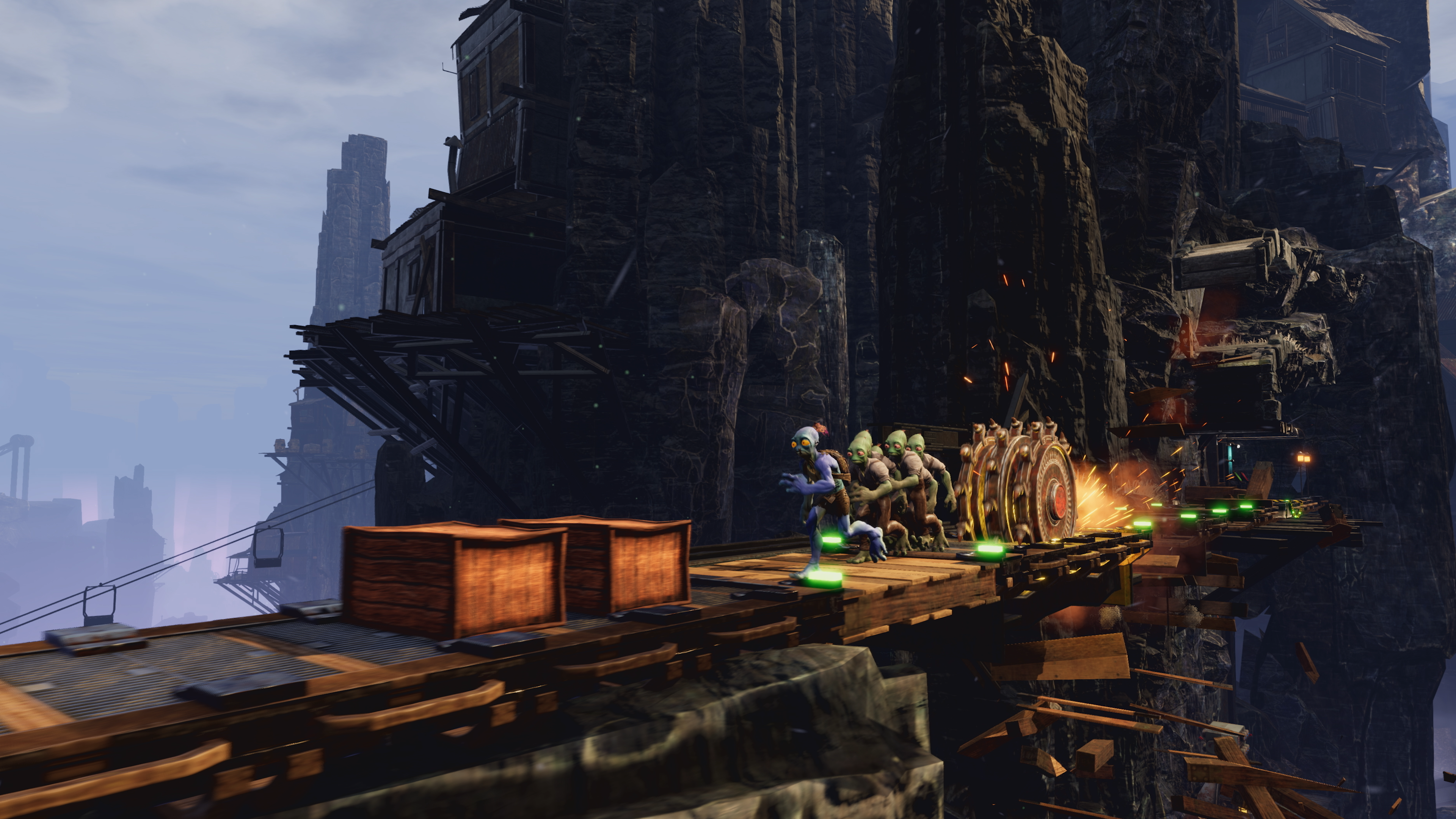
I always found it ironic that while OddWorld has always been lore-heavy media for those interested enough to pursue it, the plots were always told through diegetic storytelling that moved at a pace too quick for any significant world building to actually take place—SoulStorm is the one exception to the trend, and honestly, it’s a refreshing change.
The newest game from Oddworld Inhabitants still has some growing pains when it comes to its difficulty curve and challenge, but it’s certainly the first time in the long-running franchise that I can safely say that what I played in SoulStorm was definitely more of an experience than it was a game. Whether you were a fan of New ‘n Tasty, I still can’t recommend this game highly enough for anyone looking to expand their PlayStation library—download it now, and go see what all the fuss is about.





 GeorgieBoysAXE
GeorgieBoysAXE




